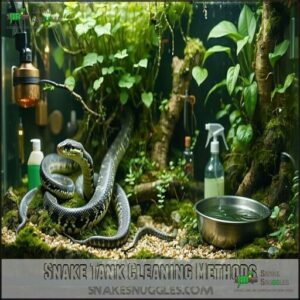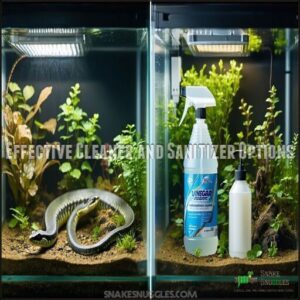This site is supported by our readers. We may earn a commission, at no cost to you, if you purchase through links.

Dispose of the old substrate, then rinse the tank using warm water. Scrub it down with a reptile-safe cleaner and sponge to remove grime and bacteria. Rinse it thoroughly and let it dry completely.
Clean all accessories, like branches and hides, with the same safe cleaner. Replace with fresh substrate, set up the decorations, and double-check the temperature and humidity levels before returning your snake.
A clean tank keeps your snake healthy and happy—it’s worth the effort!
Table Of Contents
- Key Takeaways
- Snake Tank Cleaning Methods
- Daily Cleaning and Maintenance Routine
- Deep Cleaning and Disinfection Process
- Essential Equipment and Supplies for Cleaning
- Cleaning Schedule and Frequency
- Advanced Cleaning Techniques and Tips
- Frequently Asked Questions (FAQs)
- How to clean a snake tank?
- How do you clean a snake terrarium?
- How do you clean a snake?
- Which product is best for cleaning a snake tank?
- How do you clean a snake tank with oxyfresh terrarium cleaner?
- How do you clean a snake cage?
- What is the best thing to clean a snake tank with?
- How often do you change snake bedding?
- How often should I change the water in a snake tank?
- How often should you spray your snake tank?
- Conclusion
Key Takeaways
- Remove waste daily, replace soiled substrate, and refresh the water bowl to maintain a clean environment.
- Use reptile-safe cleaners like chlorhexidine to sanitize the tank and accessories during monthly deep cleaning.
- Always rinse thoroughly and dry everything before reassembling the enclosure to prevent chemical residue.
- Maintain proper temperature and humidity levels while monitoring your snake’s comfort and health after cleaning.
Snake Tank Cleaning Methods
You’ll need to choose between spot cleaning, full cleaning, or a hybrid approach to keep your snake’s home fresh and healthy.
Each method has specific benefits for maintaining proper hygiene, preventing bacteria buildup, and ensuring your scaly friend stays comfortable in their environment.
Spot Cleaning Vs Full Tank Cleaning
Snake tank cleaning revolves around spotting and sanitizing, and each method has distinct perks.
- Spot Cleaning: Focuses on daily snake waste removal, managing odors, and keeping things stress-free for the snake. It’s quick but misses hidden bacteria.
- Full Tank Cleaning: Offers a thorough examination, sanitizing the entire habitat monthly. It’s thorough but takes more time and disrupts the snake’s environment.
- Balancing Both: A hybrid approach blends spot cleaning and full tank cleaning, reducing stress for your snake while maintaining a hygienic habitat.
Spot clean daily for odor control, and regularly sanitize to maintain health and comfort.
The Hybrid Method for Effective Cleaning
The hybrid method combines daily spot cleaning and monthly deep cleaning, making it one of the most practical snake tank cleaning techniques.
The hybrid method ensures a stress-free environment while balancing speed and sanitation for a clean, healthy snake habitat.
It’s efficient, cost-effective, and great for snake welfare since it minimizes stress.
Remove visible waste (like feces and uneaten food), replace soiled substrate, and reserve intensive cleaning for scheduled times.
This approach keeps odors under control, preserves substrate, and maintains a hygienic environment.
Remember, daily water bowl cleaning and bi-weekly decor inspections are essential to this routine.
Using this method guarantees a cleaner habitat while saving time and resources without compromising your snake’s comfort.
Benefits and Drawbacks of Each Method
Each snake tank cleaning method has its ups and downs. Spot cleaning is fast and keeps odors at bay but might leave grime hiding. Full cleaning provides the most thorough sanitation yet demands more time and can overwhelm your snake.
The hybrid method balances thoroughness without disrupting your pet’s routine too much. Maintaining proper humidity is also essential for snake health.
Here’s how they stack up:
- Spot Cleaning Pros: Quick, targets visible waste.
- Full Cleaning Cons: Time-intensive and unsettling for snakes.
- Hybrid Method Balance: Merges speed with sanitation.
- Stress Reduction: Less disruptive than frequent deep cleans.
- Time Commitment: Manages workload without sacrificing hygiene.
Daily Cleaning and Maintenance Routine
Keeping up with daily cleaning is essential for your snake’s health and comfort.
By removing waste, uneaten food, and soiled substrate, you’ll maintain a safe and hygienic environment that prevents harmful bacteria buildup.
Removing Waste and Uneaten Food
Keeping your snake’s tank clean starts with daily waste removal, including feces, food scraps, and urates.
Ignoring waste invites bacteria and mold, risking both hygiene and your snake’s health.
Use gloves and a scoop to remove snake waste safely, and toss uneaten food promptly to stop germs from spreading.
For trouble spots, spot cleaning with reptile-safe disinfectant prevents odor and bacterial buildup.
Regular feces removal and food spoilage checks keep the tank fresh, promoting a safe, stress-free environment for your snake.
To prevent issues like bacterial growth and disease, daily maintenance is key.
Replacing Soiled Bedding and Substrate
Maintaining clean bedding guarantees a fresh, odor-free tank and a comfortable space for your snake.
Follow these steps for proper substrate replacement:
- Use bedding types like aspen or coconut fiber, ideal for dust reduction and cost efficiency.
- Remove soiled sections immediately to prevent odors.
- Keep 1–2 inches of substrate to ease cleaning.
- Dispose of used substrate responsibly for hygienic tank care.
A clean snake tank substrate fosters health and happiness!
Importance of Consistent Temperature Levels
Stable temperatures aren’t just nice-to-haves—they’re non-negotiable for maintaining snake health. Sudden drops or spikes can mess with digestive health, immune function, or even shedding cycles.
Always monitor using reliable thermometers to meet your snake’s specific temperature requirements. Pair this with consistent humidity control for a balanced reptile environment.
While cleaning, double-check your heat sources and make certain thermal gradients stay intact. Think of it as preserving your snake’s personalized climate.
A clean tank is important, but proper temperature regulation keeps your snake thriving right where it belongs.
Deep Cleaning and Disinfection Process
A deep cleaning removes built-up waste and bacteria that a quick wipe can’t handle, creating a healthier habitat for your snake.
It’s essential to sanitize the enclosure and all decor thoroughly, ensuring your pet’s environment stays safe and hygienic.
Removing Built-up Waste and Bacteria
Built-up waste and bacteria can create trouble in your snake tank without quick attention. Waste buildup signs, like strong odors or grime, signal it’s time to act.
Move your snake to a safe location, then scrub surfaces with hot water and a mild, reptile-safe cleanser. Use a brush for corners and a scraper for stuck waste. Let everything dry fully to keep bacteria under control. To maintain a healthy environment, consider using a specialized reptile cleaner. Let everything dry fully to keep bacteria under control.
- Check daily for feces or uneaten food to stop buildup.
- Pick disinfectant options that don’t contain harmful chemicals.
- Remove waste safely with gloves and proper tools.
- Prevent issues by cleaning weekly and avoiding harsh products.
Stay consistent to guarantee bacteria prevention!
Sanitizing The Enclosure and Decor
Creating a healthy environment starts with thorough snake tank sanitization.
Use a reptile-safe disinfectant for all surfaces, ensuring you scrub hides, porous materials, and other decor carefully to remove contaminants.
Rinse each item fully—leftover residue can irritate your snake’s scales.
For decor sterilization, bake wooden items at 250°F for 30 minutes or wash them with hot water.
Avoid harsh chemicals like bleach—it’s risky for your snake.
Natural sanitizers, such as diluted vinegar, are safer alternatives.
Don’t forget the water bowl: wash it with dish soap, rinse thoroughly, and dry to prevent bacteria.
Consider where to buy proper supplies for a healthy habitat.
Consistent use of safe disinfectants and proper cleaning of reptile accessories keeps your snake happy and healthy in a fresh, sanitized habitat.
Reassembling and Maintaining The Habitat
After deep cleaning, reassembling the habitat is like setting up a cozy retreat for your snake.
Follow these steps to guarantee comfort and safety:
- Spread fresh substrate evenly to provide a clean, soft base.
- Arrange decor like hides and branches securely to prevent accidents.
- Refill water bowls, placing them for easy access to aid hydration and snake tank odor control.
- Adjust temperature and humidity to maintain a proper gradient using thermostats and hygrometers.
- Observe your snake’s behavior after reintroducing it, confirming it’s comfortable with hiding spots and overall setup.
Selecting the right one guarantees proper snake bedding.
Essential Equipment and Supplies for Cleaning
To clean your snake tank properly, you’ll need the right tools and supplies ready to go.
From disinfectants to scrubbing brushes, having these essentials on hand guarantees a safe and hygienic environment for your pet.
Recommended Cleaning Tools and Materials
Having the right tools makes snake tank cleaning a breeze. Rubber gloves are a must—they keep your hands safe from waste and cleaning chemicals. A sturdy scrubbing brush is perfect for grime, while softer sponges handle surfaces without scratches.
Spray bottles let you apply safe disinfectants evenly, sanitizing your snake’s home without putting them at risk. When tackling waste, a lined bucket comes in handy for quick disposal, and paper towels make drying surfaces fast and easy.
Tank scrapers are great for removing stubborn urates, while reptile wipes simplify daily tidying. Don’t forget cleaning gloves for added protection and comfort. These tools help ensure a healthy, happy home for your snake.
For natural decorations like logs, sterilize them by baking at 250°F for 30 minutes to keep bacteria in check. Keep these tools handy for cleaner, safer setups, ensuring your snake has a thriving environment.
Importance of Logbook Keeping for Animal Health
Logbook keeping is a game-changer for snake health and care. By tracking feeding habits, shedding cycles, and stool changes, you’ll gain valuable Health Trend Tracking insights.
Logging tank conditions like temperature and humidity helps spot environmental shifts quickly.
- Example entry: “April 13: Fed 1 mouse, shed completed, stool normal, 80°F/55% humidity.”
Use it for Behavior Pattern Analysis, Medication Dosage Records, or even Breeding Cycle Insights.
Keep a Veterinary Visit Log to guarantee every care detail is documented. A good logbook isn’t just a record—it’s your guide for consistent cleaning, health tracking, and stress-free snake care.
Effective Cleaner and Sanitizer Options
To keep your snake healthy, always use reptile-safe disinfectants. Chlorhexidine is a top choice—gentle yet powerful for cleaning tough messes.
Prefer eco-friendly solutions? DIY options like a 50/50 mix of vinegar and water or baking soda (1 tablespoon per gallon) work well for sanitizing.
For stubborn grime, a 10% bleach solution can be effective, but rinse thoroughly to remove residue. Avoid cleaners with phenols or harsh chemicals, as they’re unsafe for reptiles.
Look for snake tank cleaning products specifically labeled safe for reptiles. With the right snake tank disinfectant and consistent care, your pet’s habitat stays clean and safe.
Cleaning Schedule and Frequency
Keeping a regular cleaning schedule is essential for your snake’s health and comfort.
By balancing daily spot cleaning with monthly deep cleaning, you can maintain a safe and hygienic habitat.
Monthly and Deep Cleaning Schedule
A well-planned snake tank cleaning schedule guarantees your snake stays healthy.
Complete a deep clean monthly, focusing on fully replacing substrate and sanitizing the tank and decor with reptile-safe products.
Always rinse thoroughly and let everything air dry to avoid residue.
- Quick Tip: Spot-check your substrate lifespan—messy snakes or fossorial species may require more frequent deep cleaning steps to maintain hygiene.
Importance of Regular Cleaning for Animal Health
Maintaining a clean snake tank isn’t just about appearances—it’s about protecting your snake’s health. Poor hygiene can allow Germ Buildup, leading to respiratory infections, scale rot, or worse. Regular cleaning keeps bacteria at bay and maintains a Safe Habitat for your pet.
Regular cleaning protects your snake’s health, preventing bacteria buildup and creating a safe, stress-free habitat for your scaly companion.
Stick to this simple routine for stress-free reptile enclosure maintenance:
- Daily: Spot-clean waste and remove uneaten food to promote Hygiene and prevent odors.
- Weekly: Replace soiled bedding and refresh water bowls to maintain snake health.
- Monthly: Deep clean the entire tank to eliminate hidden bacteria.
Consistency guarantees infection prevention, reduces snake stress, and promotes overall snake tank hygiene. It’s a simple way to prioritize reptile health.
Tips for Reducing Infection Rates
Preventing infections in your snake isn’t hard but does take consistent care.
Start with daily spot cleaning to remove waste and uneaten food. This simple task keeps bacteria like salmonella from building up.
For better reptile hygiene, refresh the substrate weekly to control odors and cut down on bacteria growth.
Every 4-6 weeks, tackle infection prevention with a deep clean using reptile-safe disinfectants. Remove everything in the tank, sanitize all surfaces, and rinse thoroughly to avoid chemical residue.
Pay extra attention to accessories like water dishes and hides—they harbor hidden snake bacteria if left unchecked.
One vital aspect is to follow a snake mite infestation prevention guide to avoid potential health risks.
Make certain proper ventilation in the tank to stop moisture buildup, which encourages bacterial growth.
When handling your pet, practice good hygiene by washing your hands before and after.
Advanced Cleaning Techniques and Tips
When it’s time to go beyond basic cleaning, advanced techniques help keep your snake’s enclosure truly pristine.
From sanitizing decor to maintaining sterile surfaces, these steps guarantee a safe and healthy habitat.
Baking and Disinfecting Branches and Decor
Sanitizing branches and decor is a must for maintaining your snake’s habitat. Natural decor like wood needs proper cleaning to avoid bacteria buildup while protecting your pet.
Here’s how to handle it safely:
- Scrub dirt from items using a brush and hot water.
- Make certain everything is fully dry before heating.
- Bake wood at 250-300°F for 30 minutes to kill pathogens.
- Cool baked items before returning them to the enclosure.
- For non-bakeable pieces, use a reptile-safe disinfectant or DIY sterilization with diluted bleach (rinsed thoroughly).
This method guarantees your snake decor stays clean and safe, avoiding risks while enhancing tank hygiene.
Sanitizing Electric Appliances and Surfaces
Keeping devices clean is part of good reptile tank sanitation.
Before heat mat sanitizing or thermostat cleaning, unplug everything. Don’t risk a shock!
Use reptile-safe products like chlorhexidine for cleaning reptile accessories. Harsh chemicals, like bleach or alcohol, can damage electronics.
Focus on these steps:
- Unplug all devices: Heat mats, misting systems, and lights.
- Apply safe cleaning solutions: Mist lightly with disinfectant.
- Wipe gently: Use soft cloths to avoid scratches.
- Inspect cords: Check for damage during cleaning.
- Allow full drying: Any moisture could cause damage later.
Clean surfaces keep reptiles healthy and equipment running smoothly!
Maintaining a Sterile Environment for Your Snake
If you want to prevent illnesses, maintaining a sterile environment in your snake’s tank is vital. Start with daily waste removal to stop bacteria buildup.
Use reptile-safe disinfectants like diluted chlorhexidine during tank sanitizing, but rinse everything well—snakes hate damp décor. Replace soiled substrate regularly and focus on substrate sterilization every few weeks.
To prevent disease spread, quarantine new snakes for a minimum of 30 days. Quarantine protocols are a must when introducing new items.
Clean tools like gloves and scrapers help avoid contamination. Finally, guarantee good air quality and water purity in the tank to keep your snake healthy and stress-free.
Frequently Asked Questions (FAQs)
How to clean a snake tank?
Cleaning a snake tank is like tidying a miniature ecosystem.
Remove waste daily, disinfect monthly with reptile-safe products, and replace soiled substrate.
Verify all accessories are cleaned and dried before reassembling the enclosure, ensuring a reptile-safe environment and a miniature ecosystem that is clean and healthy.
How do you clean a snake terrarium?
Start by removing your snake to a temporary, safe container.
Spot clean waste daily, replace soiled substrate weekly, and deep clean monthly.
Use reptile-safe disinfectant, rinse thoroughly, then dry everything before returning decorations, following a routine that includes deep clean monthly.
How do you clean a snake?
Gently handle your snake, placing it in lukewarm water for five to ten minutes.
Use a damp, soft cloth to remove visible dirt from its body.
Avoid soaps or chemicals that can harm its skin.
Which product is best for cleaning a snake tank?
Choose a reptile-safe disinfectant like Zoo Med Wipe Out 1 or chlorhexidine.
Avoid pine-scented or phenol-based cleaners, as they’re harmful.
Pair with tools like sponges, toothbrushes, and gloves for thorough, safe cleaning, using a reptile-safe disinfectant to ensure a safe environment.
How do you clean a snake tank with oxyfresh terrarium cleaner?
Spark spotless surroundings by spraying Oxyfresh Terrarium Cleaner directly on surfaces.
Scrubbing with a soft brush, and allowing it to sit briefly, is a crucial step in the process.
Wipe thoroughly with a clean cloth. It’s safe, simple, and snake-friendly!
How do you clean a snake cage?
Clean a snake cage by removing waste daily, washing the water bowl, and wiping surfaces.
Deep clean monthly by replacing substrate, disinfecting decor with reptile-safe cleaner, and rinsing thoroughly to maintain a hygienic, safe environment.
What is the best thing to clean a snake tank with?
Picture a cozy retreat turned unsanitary nightmare.
Use a 10% bleach solution, warm water, and reptile-safe disinfectants like chlorhexidine. Avoid pine-scented products and rinse thoroughly.
These tools guarantee your snake’s sanctuary stays hygienic and safe.
How often do you change snake bedding?
Change your snake’s bedding every 3-4 weeks or sooner if it’s soiled.
Spot clean daily to remove waste, and keep an eye on hidden messes if you’re using deep substrates like aspen or coconut.
How often should I change the water in a snake tank?
You should change your snake’s water daily to keep it fresh and free of bacteria.
Snakes often soak in their bowls, so regular changes prevent contamination and guarantee your pet stays healthy and hydrated.
How often should you spray your snake tank?
Think of your snake’s tank as a tropical vacation spot.
Mist only if the species requires high humidity. For basic needs, spray every few days to maintain proper levels.
Monitor with a hygrometer to ensure you’re meeting the required humidity levels.
Conclusion
Keeping your snake’s tank clean is like maintaining a safe home—it protects their health and happiness.
By following these methods, you’ll master how to clean a snake tank efficiently, ensuring their habitat stays hygienic and comfortable.
Regular spot cleaning, deep cleaning, and proper disinfection prevent harmful bacteria while keeping conditions ideal.
Don’t rush; take time to double-check everything, from substrate to temperature. A well-maintained enclosure means a thriving snake—a small effort for a big reward!
















